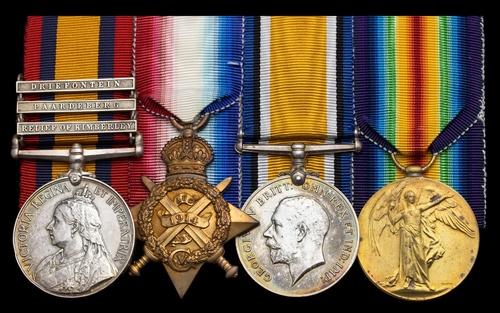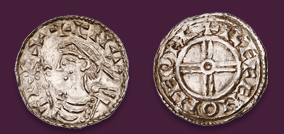
Auction: 24113 - Orders, Decorations and Medals - e-Auction
Lot: 411
(x) Four: Serjeant G. Robins, Royal Field Artillery, who served with ‘Q’ Battery at Sannah’s Post in March 1900
Queen’s South Africa 1899-1902, 3 clasps, Relief of Kimberley, Paardeberg, Driefontein (31182 Gnr., Q. B. R.F.A.[sic]); 1914 Star (31182 Gnr., R.H.A.); British War and Victory Medals (31182 Sjt., R.A.), mounted court-style for wear, good very fine and better (4)
Note: Robin's Q.S.A. was incorrectly named to the 'R.F.A.' instead of the 'R.H.A.'
George Robins was born at Ramsgate, Kent in 1880 and enlisted at Dover on 7 December 1898. Posted to 'Q' Battery, Royal Horse Artillery he was to see intense action with them the next year on the outbreak of the Anglo-Boer War and the bloody action at Sannah's Post.
Sannah's Post
Utilising the cover of a deep spruit created by the Modder River, approximately 1600 Boers, supported by artillery from high ground, deployed in darkness and surprised the British, creating chaos amid a maelstrom of mauser-fire. As Broadwood's force began to withdraw from the main body of attack towards the direction of a ravine, a blocking force of 400 Boers held fire until large numbers of British troops lay squarely within their sights, entirely devoid of cover or any realistic opportunity to fight back without being slaughtered. Over 200 were forced to surrender in the first few minutes including six guns of 'U' Battery. Those stragglers to the rear of the captured main body faced the almost suicidal return towards the only cover available - a railway station - across 1300 yards of open ground.
Within minutes, the Boers successfully captured over 100 wagons and a further artillery piece. The British began to retreat towards the station and it was amidst this apparently hopeless situation that the men of 'Q' Battery under Major Phipps-Hornby, joined by a single gun from 'U' Battery and the Mounted Infantry, decided to stand their ground and fight back. For four hours they fought continuously, aided by rifle fire from the railway station, and managed to transform a stampede into an orderly retreat. Those who managed to escape under the cover of British artillery were fortunate; had it not been for an eagle-eyed officer who noticed what was happening in the first few minutes and ordered 'Q' Battery to gallop away towards the railway buildings, the outcome may have been disastrous.
Broadwood eventually managed to break contact and approximately three hours later the 9th Infantry Division commanded by Major General Sir Henry Colville arrived to relieve the Mounted Brigade. The element of surprise now lost, the Boers withdrew to highly defensive positions across the Modder River leaving a small garrison at the captured waterworks. The British forces, now low on ammunition, chose to retire from the field.
The conduct of the battery was praised by Brigadier-General Broadwood in his report on the action. As a result of this report, Lord Roberts took the unusual step of ordering the battery to ballot for the Victoria Cross, to choose one officer, one non-commissioned officer, one gunner and one driver to receive the coveted award, there being no other fair way to choose four from so many who performed so heroically on that day. As a result, Major Edmund John Phipps-Hornby, Sergeant Charles Edward Haydon Parker, Gunner Isaac Lodge, and Driver Horace Henry Glasock were each awarded the Victoria Cross. Gunner G. Robin's name would have been in the ballot for the Victoria Cross to the 'Gunner'.
Epilogue
Robins was invalided from South Africa in July 1900 however he was to see action again during the Great War. Entering the War in France on 15 August 1914 he was advanced Sergeant in 1917. Later posted to the 4th Reserve Brigade, Robins was finally discharged in February 1919; sold together with assorted research.
Further entitled to a 1914 Star and Great War Pair.
Subject to 5% tax on Hammer Price in addition to 20% VAT on Buyer’s Premium.
Sold for
£650
Starting price
£320




